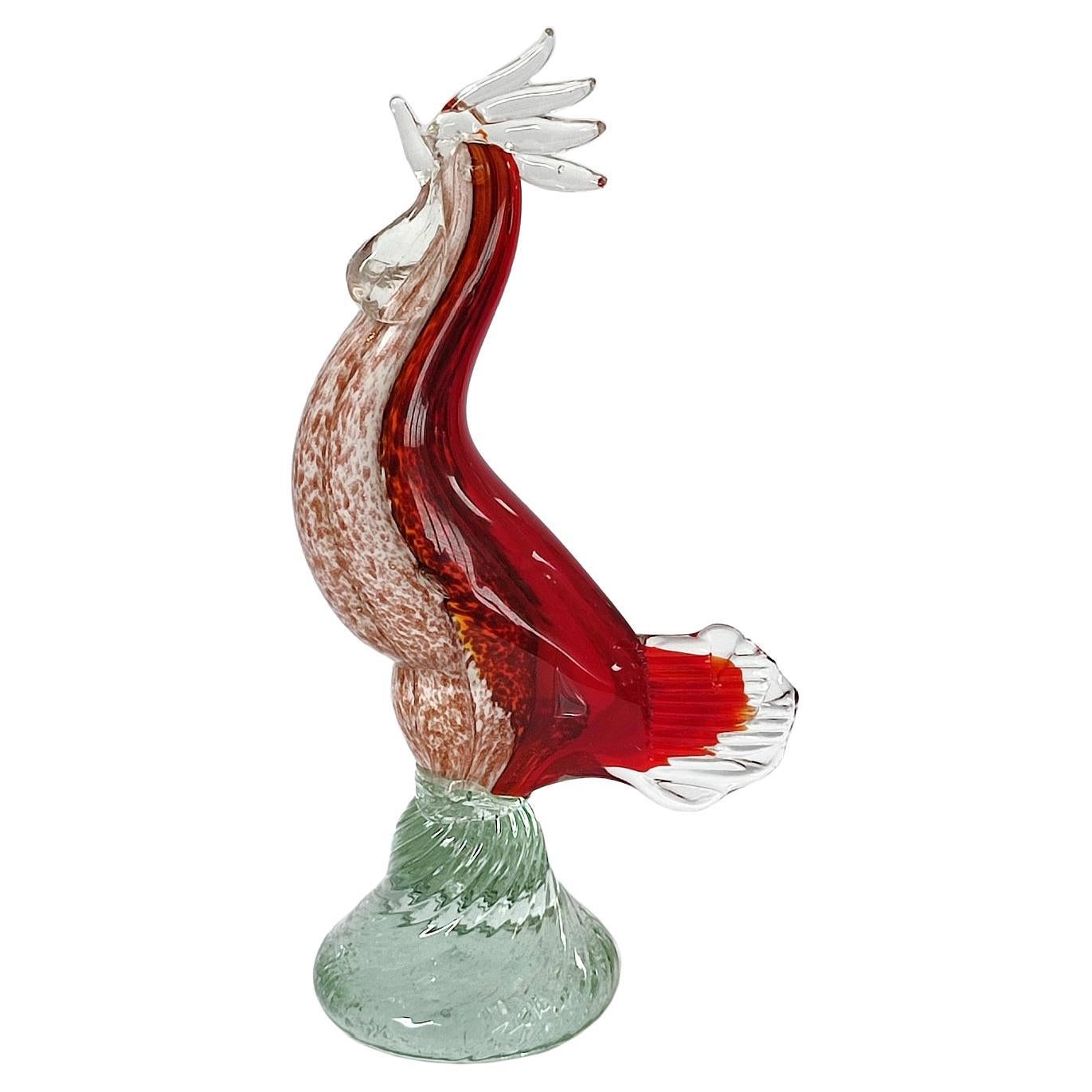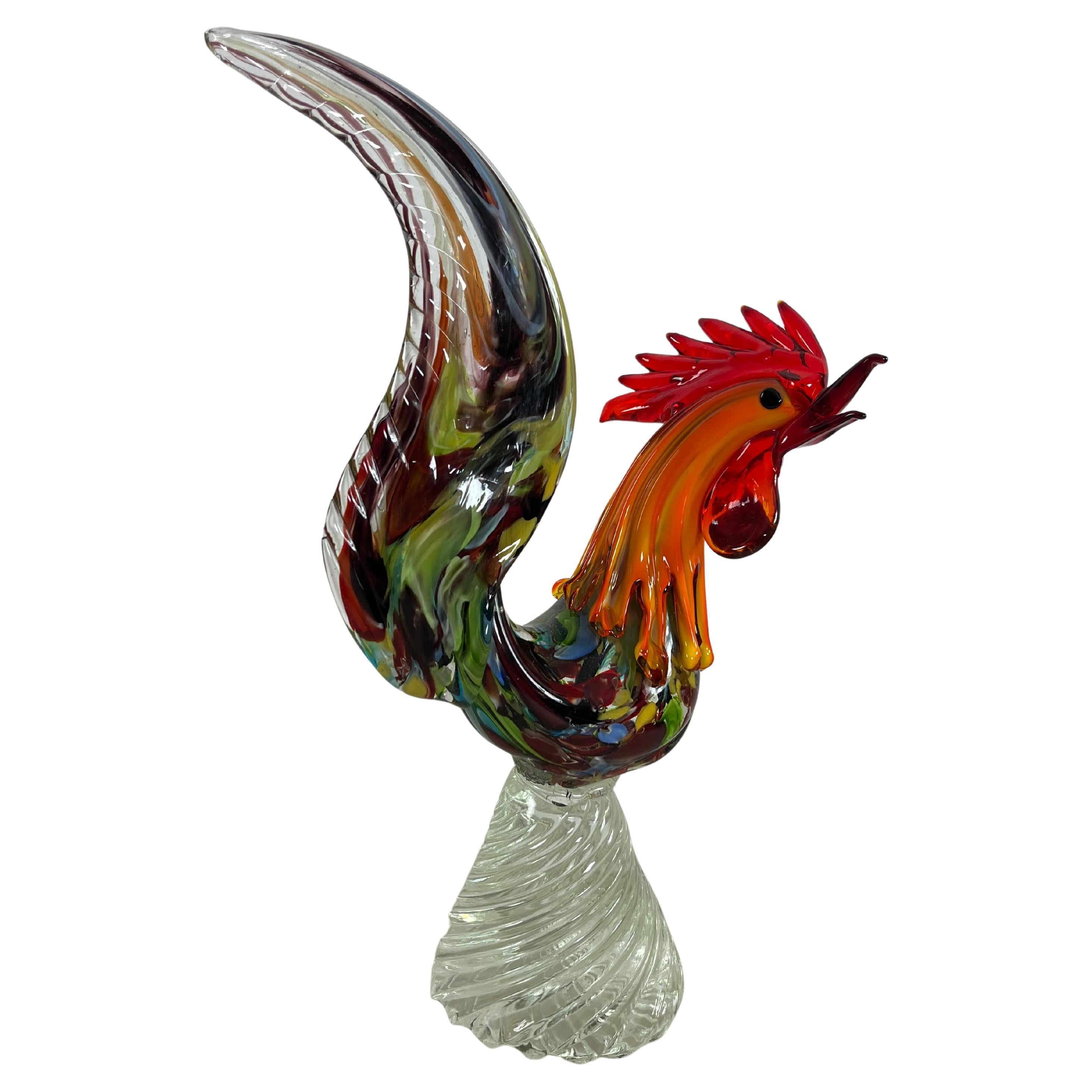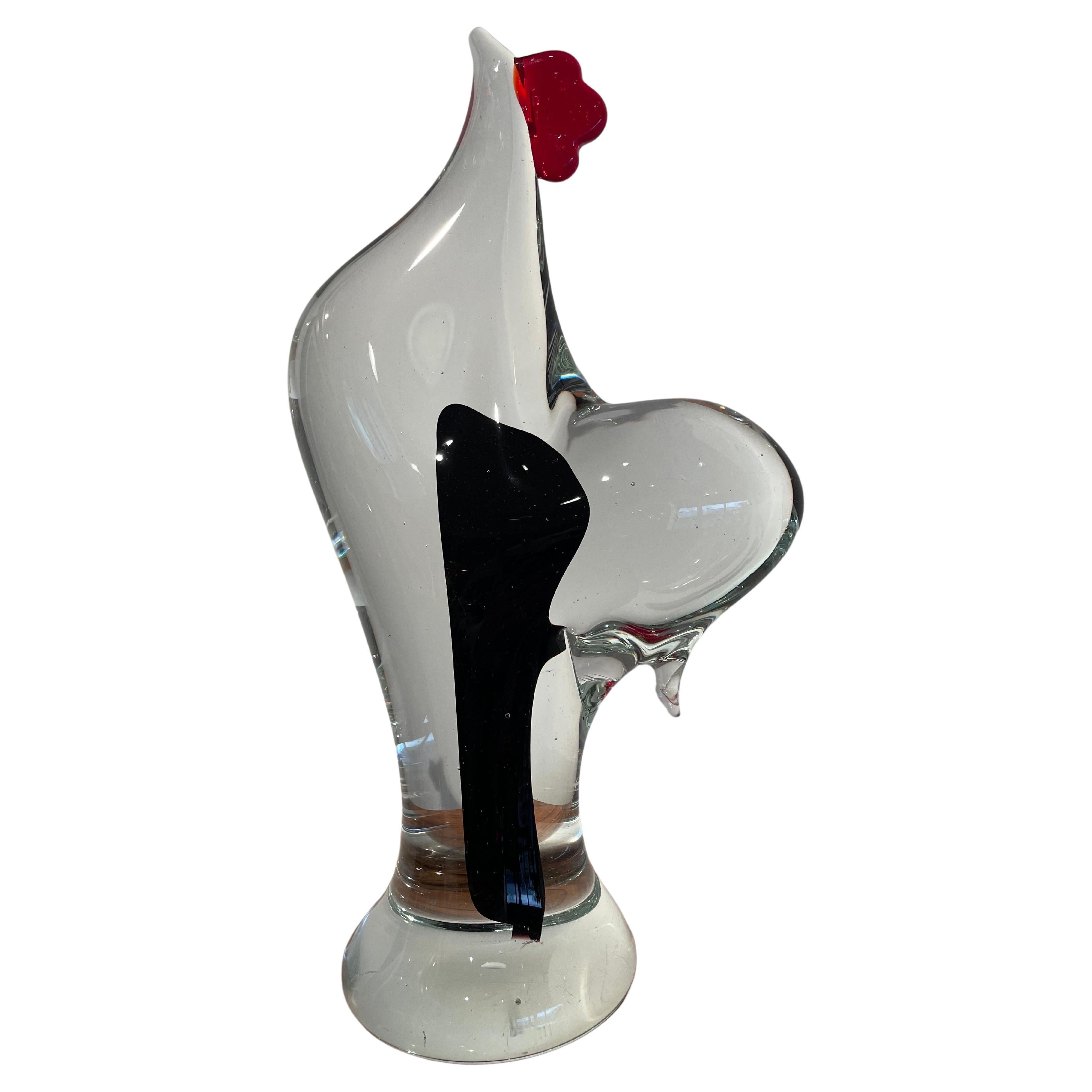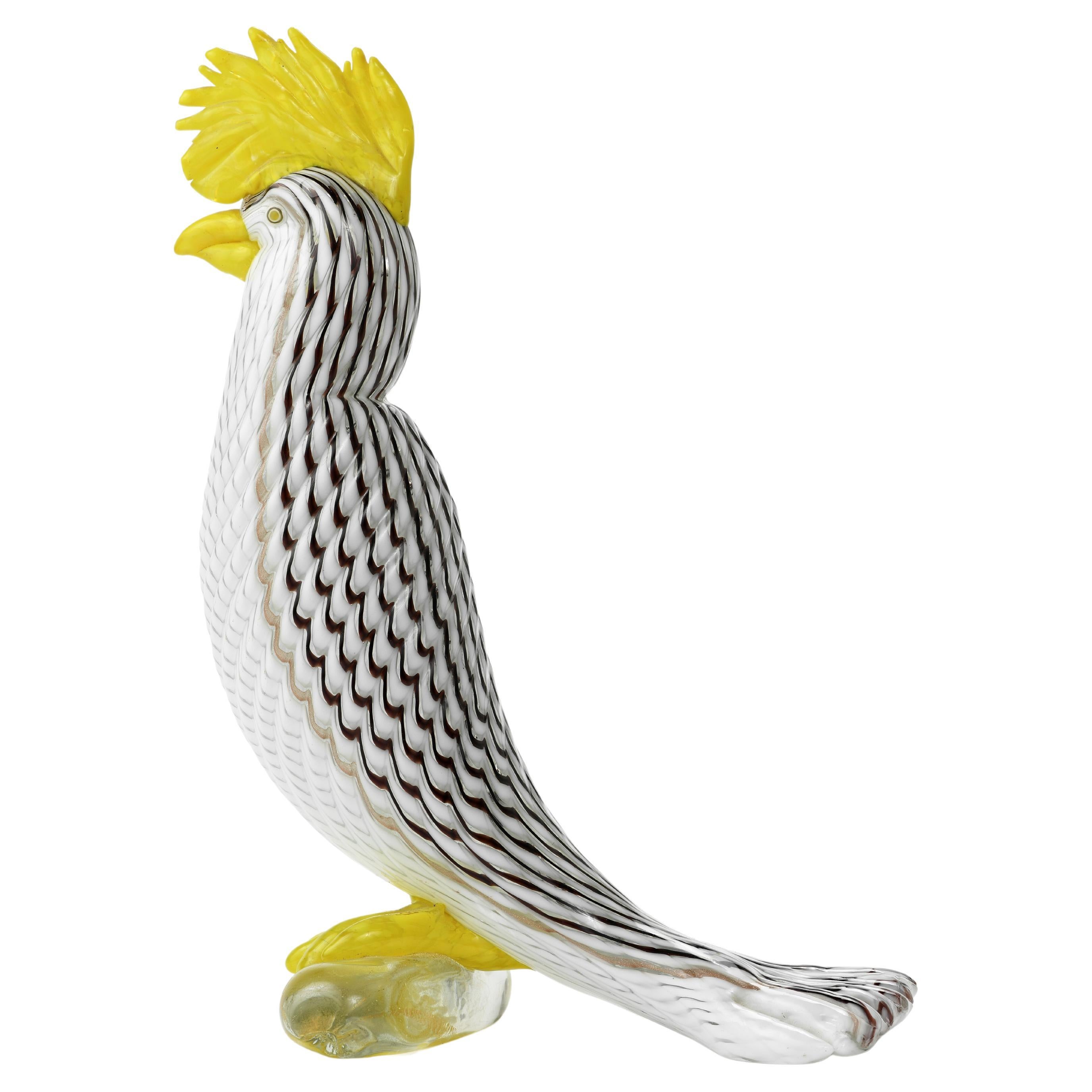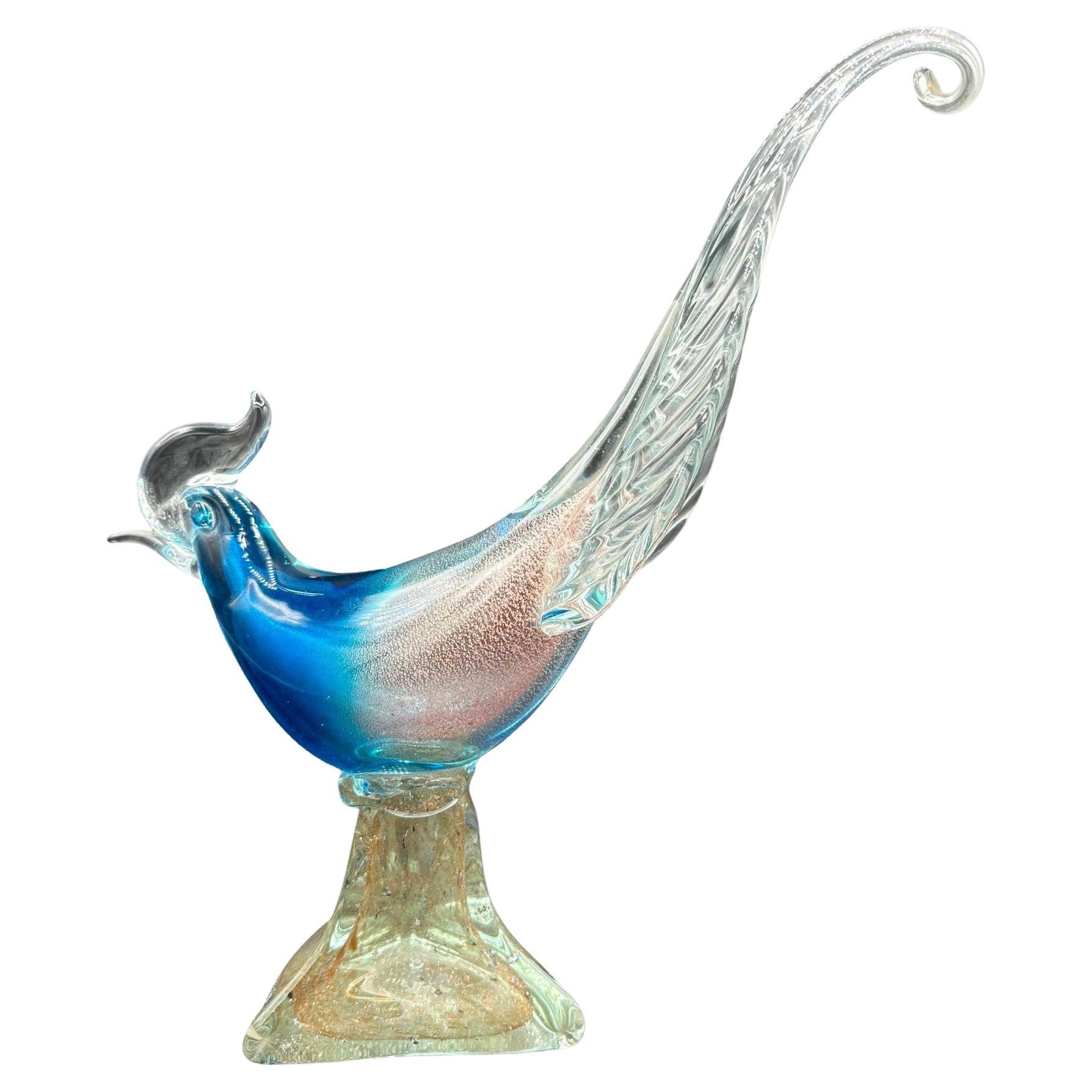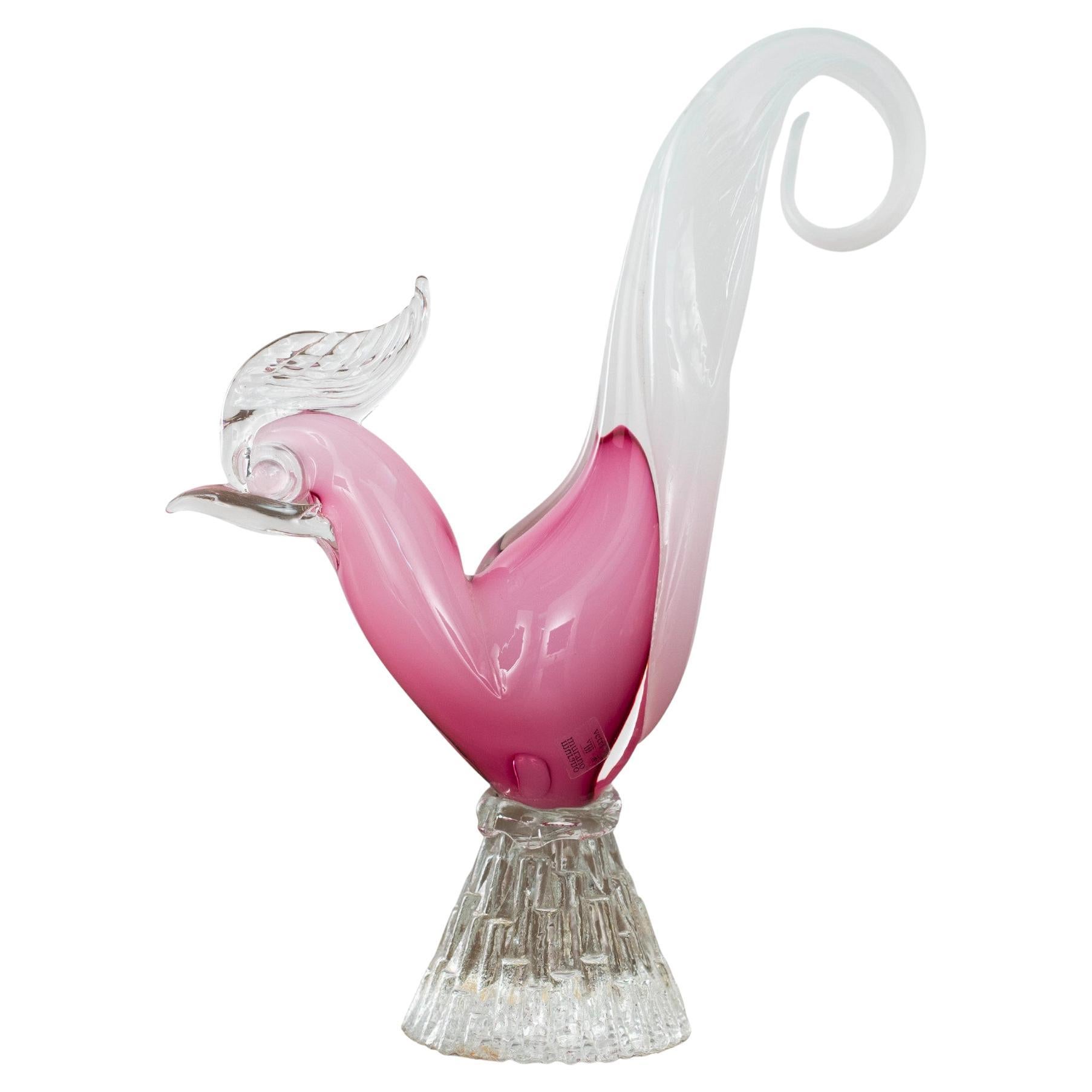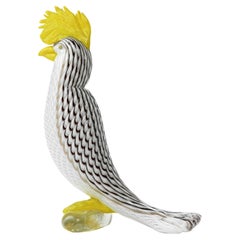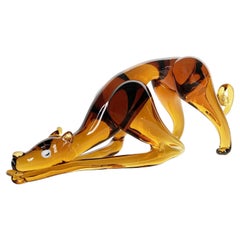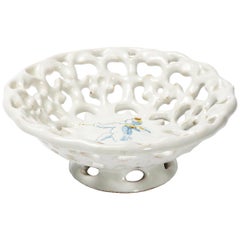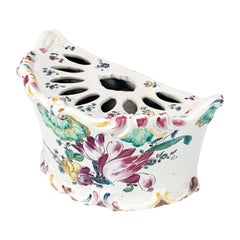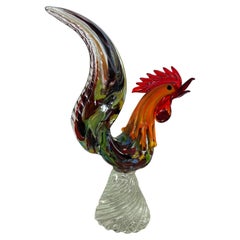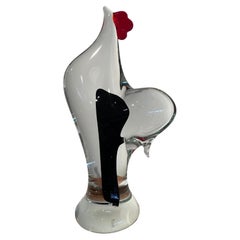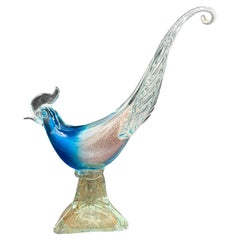Items Similar to Murano Glass Rooster-Shaped Sculpture, Dino Martens, Venice Aureliano Toso, 1954
Video Loading
Want more images or videos?
Request additional images or videos from the seller
1 of 19
Murano Glass Rooster-Shaped Sculpture, Dino Martens, Venice Aureliano Toso, 1954
$5,391.65
£4,013.73
€4,500
CA$7,385.21
A$8,213.96
CHF 4,289.08
MX$99,955.19
NOK 54,778.05
SEK 51,372.14
DKK 34,256.93
Shipping
Retrieving quote...The 1stDibs Promise:
Authenticity Guarantee,
Money-Back Guarantee,
24-Hour Cancellation
About the Item
Rooster- shaped sculpture Galletto
Dino Martens (1894 - 1970)
Vetreria Artistica Rag. Aureliano Toso, 1954
It measures 9.25 inches in height x 8.18 in x 4.4 in (23.5 cm x 20.8 cm x 11.4 cm)
It weighs 2.57 lb (1.169 g)
State of conservation: intact.
The small glass sculpture depicts a cockerel standing on a hemispherical base, with the crest open and turned back and the beak adorned with wattles. The object is made with a particular reed-blowing technique with “filigrana semplice” using “lattimo”, red and gold glass, and has details in achromatic paste and gold leaf. It was produced at the Vetreria Aureliano Toso from 1954 according to a design by Dino Martens.
In the factory archives the production of small roosters is documented starting from 1954: model no. 6095 by Martens (Cristina Beltrami, Giordana Naccari (a cura di), L’arca di vetro, La collezione di animali di Pierre Rosenberg, Skira, 2021, p. 153, n. [240]) is named in the archive: “filigrana semplice – Rooster on base” (M. Heiremans, Vetreria Aureliano Toso, Murano 1938-1968, Berlino, 2016, p. 330, model n. 6096, list 1954). In 1956 the glass factory began to produce other versions of roosters.
A precise comparison with this model comes from a similar sculpture exhibited in a recent exhibition, with an evocative title L’Arca di vetro. La collezione di animali di Pierre Rosenberg. This exhibition traced the history of twentieth century Murano glass, reinterpreted through a vast assortment and original creations of animal shapes. In this review, a Galletto similar to ours, but made with the reed-blowing technique with “filigrana semplice” using “lattimo” and black glass, is associated with the production of 1954 (Cristina Beltrami, Giordana Naccari (a cura di), L’arca di vetro, La collezione di animali di Pierre Rosenberg, Skira, 2021, p. 160, n. 240).
The history of Murano glass is varied and complex. Since the 1920s, the Murano tradition has evolved from the production of everyday objects to decorative ones: some glassmakers try their hand at creating human figures, sculptures, and zoomorphic elements in miniature.
The technique is refined and leads the artisans to devise new methods that allow the creation of both blown and massive figures.
A tradition of “Bagatelle” is known as early as the 16th century and throughout the 17th century and some objects come down to us from the wunderkammer as examples "alla maniera di Venezia (in the Venetian style)". Some rare examples are preserved in museums. Among these, the plastic decorations of the chandeliers and other molded lanterns stand out.
However, only in the twentieth century did a real turning point in technique and design come about: a production that recently found its enhancement with the rediscovery of the sculptural works produced by the main historic Murano glassworks, from Ercole Barovier to Martinuzzi and Zecchin, as well as Flavio Poli and Dino Martens, in a succession of increasingly complex creations.
Between 1930 and 1960 the production of “bestiary” glass evolved and moved from the simpler forms of the Thirties to more complex works in terms of morphology and technique. All this is evident in the Forties with Barovier, and in the Fifties with Bianconi, who, along with Dino Martens, carried out research into designs using “filigrana” and polychromy, without neglecting the research into opacity by Archimede Seguso. The glass animal thus becomes and remains an obligatory passage in Murano artistic production, a work of experimentation and formal research, inspired both by reality and the inventiveness of its creation.
The work of Dino Martens (1894 - 1970) fits into this context, considered by many to be an artist with a gift for glass work. After the early postwar period, he trained at the Accademia di belle arti di Venezia and initially dedicated himself to painting. After his initial experiences with glass with SALIR and with Salviati & C., he arrived in 1939 at the manufacture of the ragionier Aureliano Toso. It was here that he would become artistic director until 1963, experimenting with the material to create completely new color and formal effects.
Bibliography:
Cristina Beltrami, Giordana Naccari (a cura di), L’arca di vetro, La collezione di animali di Pierre Rosenberg, Skira, 2021, p. 153 n. 240 e n. [240];
Marc Heiremans, Vetreria Aureliano Toso, 1938-1968, Arnoldsche Art Publishers, p. 330, model n. 6096, list 1954.
- Creator:Dino Martens (Designer)
- Dimensions:Height: 9.26 in (23.5 cm)Width: 4.49 in (11.4 cm)Depth: 8.19 in (20.8 cm)
- Style:Modern (Of the Period)
- Materials and Techniques:
- Place of Origin:
- Period:
- Date of Manufacture:circa 1954
- Condition:Intact.
- Seller Location:Milano, IT
- Reference Number:1stDibs: LU4352232663882
About the Seller
4.3
Vetted Professional Seller
Every seller passes strict standards for authenticity and reliability
Established in 1860
1stDibs seller since 2018
21 sales on 1stDibs
Associations
International Confederation of Art and Antique Dealers' Associations
- ShippingRetrieving quote...Shipping from: Milano, Italy
- Return Policy
Authenticity Guarantee
In the unlikely event there’s an issue with an item’s authenticity, contact us within 1 year for a full refund. DetailsMoney-Back Guarantee
If your item is not as described, is damaged in transit, or does not arrive, contact us within 7 days for a full refund. Details24-Hour Cancellation
You have a 24-hour grace period in which to reconsider your purchase, with no questions asked.Vetted Professional Sellers
Our world-class sellers must adhere to strict standards for service and quality, maintaining the integrity of our listings.Price-Match Guarantee
If you find that a seller listed the same item for a lower price elsewhere, we’ll match it.Trusted Global Delivery
Our best-in-class carrier network provides specialized shipping options worldwide, including custom delivery.More From This Seller
View AllGlass Parrot-Shaped Sculpture, Dino Martens, Venice, Aureliano Toso, 1953-1956
By Dino Martens
Located in Milano, IT
Parrot-shaped sculpture Psitaccus
Dino Martens (1894 - 1970)
Vetreria Artistica Rag. Aureliano Toso, 1953-1956
It measures 9.055 inches in height x 4.13 in x 5.90 in (23 cm, 10.5 cm x 15 cm)
It weighs 1.997 lb (906 g)
State of conservation: intact.
The small glass sculpture...
Category
Vintage 1950s Italian Modern Glass
Materials
Blown Glass
Greyhound - Shaped Glass Sculpture, Flavio Poli, I.V.A.M. Murano, Circa 1930
By Flavio Poli
Located in Milano, IT
Greyhound - shaped glass sculpture
Flavio Poli
I.V.A.M. Murano, circa 1930
It measures 4.72 in in height x 12.59 x 3.74 (12 cm x 32 x 9.5)
It weighs 2.42 lb (1.1 kg)
State of conse...
Category
21st Century and Contemporary Italian Modern Animal Sculptures
Materials
Murano Glass
Ancient Italian Renaissance Maiolica Crespina, Faenza, 1580 Circa
Located in Milano, IT
Crespina
Faenza, last quarter of the 16th century
Maiolica painted in two colors, light blue and yellow, on a thick, rich layer of white enamel.
It measures 2.24 in (5.7 cm) in height, 6.10 in (15.5 cm) in diameter.
lb 0.55 (kg 0.25)
State of conservation: mimetic restoration.
The small cup has a raised central “umbone”, a perforated brim and a shaped rim. It rests on a high jutting foot. The "crespina" shape, in some inventories is cited as "tacce de frute" (fruit cups). It was particularly appreciated in the Renaissance and has variants based on the formal types and the different sizes. The decoration, made according to the dictates of the “compendiario” style, used few standardized colors: blue and yellow on a thick white and shiny enamel, deliberately chosen as the colour which was most reminiscent of silver. This choice derived from a trend in creative design of the era: the shapes used in the molds were often taken from metal objects. An idea which would last throughout the Renaissance.
The work shows, in the middle of the “umbone”, a winged putto stepping forward while playing a long thin trumpet.
The depiction of the putto is fully representative of the repertoire of the Faenza workshops of the sixteenth century.
Some specimens with this type of decoration have been published in a volume by Carmen Ravanelli Guidotti: there appears the whole productive repertoire of this fundamental moment of transition between the taste for the “istoriato” style and the great simplification of decoration in the “compendiario” period. This style, in its simplicity, however, saw its expression in a rather varied collection of decorative subjects, including old-fashioned busts...
Category
Antique 16th Century Italian Renaissance Ceramics
Materials
Maiolica
Ancient Maiolica Flower Pot Pasquale Rubati Factory, Milan Circa 1770
By Pasquale Rubati
Located in Milano, IT
Maiolica flower pot “a mezzaluna” decorated with tulip
Pasquale Rubati Factory
Milan, circa 1770.
Measures: 4.7 in x 4.7 in x 8.6 in
12 cm x 12...
Category
Antique 1770s Italian Rococo Ceramics
Materials
Maiolica
Rococo Italian Maiolica Flower Pot Pasquale Rubati, Milano, 1770 circa
By Pasquale Rubati
Located in Milano, IT
Maiolica flower pot “a mezzaluna” with support feet
decorated with little bunches of flowers
Pasquale Rubati Factory
Milan, circa 1770
5.5 in X ...
Category
Antique 1770s Italian Rococo Ceramics
Materials
Maiolica
Ancient Maiolica Cup, Rubati Manufacture, Milan, Circa 1770 - 1780
By Pasquale Rubati
Located in Milano, IT
Sick cup
Pasquale Rubati Manufacture
Milan, Circa 1770 - 1780
Maiolica decorated in polychrome “a piccolo fuoco” (third fire)
It measures: h 2.36 x 7.4 x 7.87 (h 6 x 19 x 20 cm)
...
Category
Antique 1770s Italian Rococo Ceramics
Materials
Maiolica
You May Also Like
Vintage Genuine Murano Glass Rooster
By Arte Vetraria Muranese (AVEM)
Located in Bochum, NRW
Beautiful vintage Murano glass chicken intricately made in several glass techniques. Breast made of aventurine speckled glass encased in lattimo, ...
Category
Vintage 1960s Italian Mid-Century Modern Animal Sculptures
Materials
Glass
$364 Sale Price
32% Off
Large Rooster Mid-Century Multicolor Murano Glass, 1960s
Located in Palermo, IT
Large rooster Mid-Century multicolor Murano glass, 1960s
Good condition, found in an apartment in my city, Palermo.
Category
Vintage 1960s Italian Animal Sculptures
Materials
Murano Glass
Italian Mid Century Modern Blown Glass Rooster by, Antonio Da Ros for Cenedese
By Antonio da Ros, Cenedese
Located in Englewood, NJ
An Italian Mid-Century Modern blown glass "Rooster" designed by, Antonio Da Ros for Cenedese. The rooster with applied red comb with clear body "sommerso" technique (layering of glass) with the center a black against a heavily cased clear background. The rooster is cased in multiple layers of clear glass giving it a depth of dimension and weight. The rooster is unsigned. circa 1960s'
Measurements:
height: 13.25 in in. x width: 7.25 in. x depth: 4.25 in.
Biography:
Antonio Da Ros (Italian; 1936-2012) graduated in 1957 from the Istituto Superiore di Arti Decorative ‘CARMINI’ in Venice.
In 1958, he started working in the Gino Cenedese glass factory which later became Ars Cenedese Murano...
Category
Mid-20th Century Italian Mid-Century Modern Animal Sculptures
Materials
Art Glass
Mide-century Murano Pheasant Art Glass Sculpture attributed to Barovier & Toso
By Barovier&Toso
Located in Van Nuys, CA
Mid-century Murano Art Glass Pheasant Figurine Attributed to Barovier & Toso, this exquisite mid-century sculpture features a striking deep blue hue enhanced by controlled bubbles an...
Category
Vintage 1950s Italian Mid-Century Modern Animal Sculptures
Materials
Art Glass
$327 Sale Price
44% Off
Vintage Rooster Sculpture silk pink Murano glass collectable Formia Murano Italy
By Formia Murano
Located in Venezia, IT
Sculpture in Murano glass, pink rooster with crystal details, Italy
Dimensions: L 22 cm x H 28 cm x D 22 cm ( L 8.6" x H 11.0" x D 8.6")
We recently came across the untouched inven...
Category
Late 20th Century Italian Animal Sculptures
Materials
Murano Glass
Licio Zanetti Mid Century Murano glass sculptured cockerel
By Licio Zanetti
Located in Norwich, GB
Murano clear glass hand sculptured cockerel by Licio Zanetti. Signed to base. Circa 1960-70.
Very good condition with no chips or cracks. One small mark to note, as shown.
The Zane...
Category
Mid-20th Century Italian Mid-Century Modern Animal Sculptures
Materials
Murano Glass, Blown Glass
More Ways To Browse
Chandeliers With Animals
Glass Roosters
Red Rooster
Italian Roosters
Italy Rooster
Rare Rooster
Murano Figures
Murano Glass Figures
Lantern Stand
Venetian Glass Animals
Barovier E Toso Chandelier
Miniature Glass Animals
Art Glass Rooster
Dino Martens For Aureliano Toso
Venetian Lantern
17th Century Chandelier
Red Rooster Vintage
Barovier Chandelier Color
